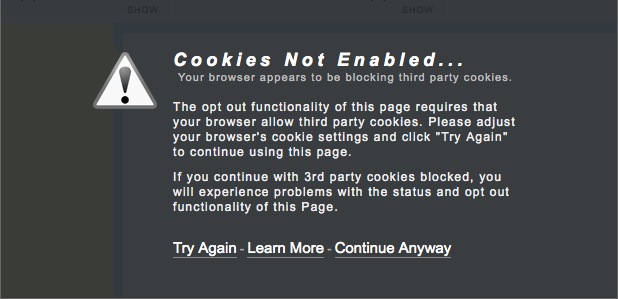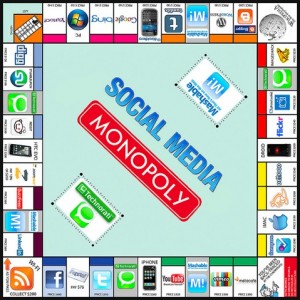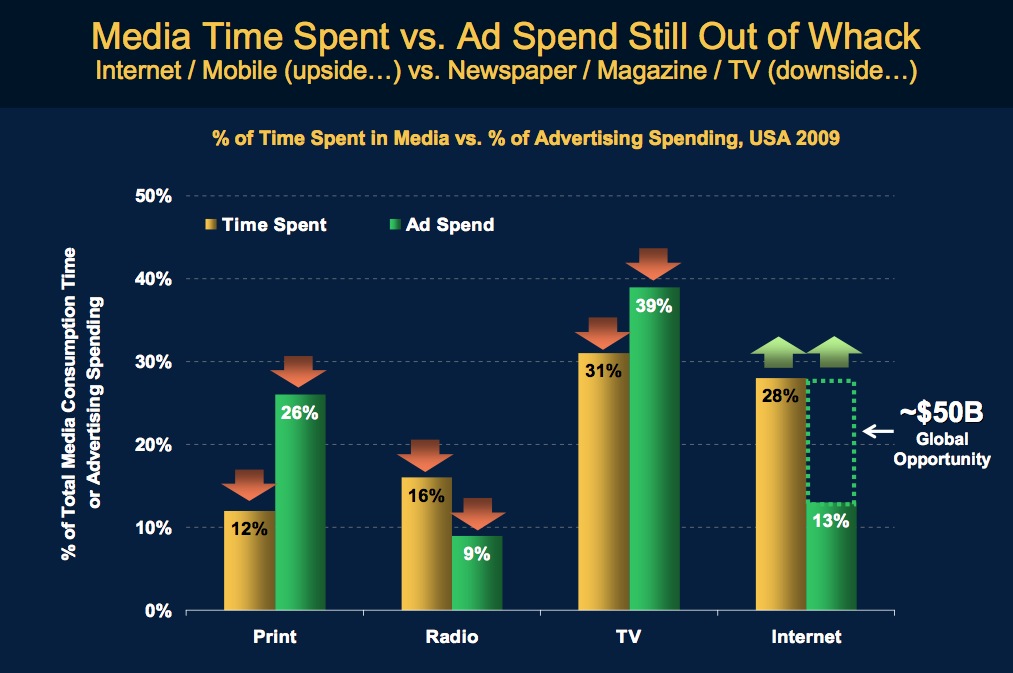InnoTech Conference Teeming With Emerging Trends
October 25, 2011

Sean Lowry, Exe. Dir., Innotech and Carrie Vanston, Co-Author, MINITRENDS at Innotech Conference, Photo by Sloan Foster
I’ve attended the InnoTech Conference and Expo and its associated eMarketing Summit for several years now and always learn a lot. This year I wanted to pass on some comments from experts that I heard yesterday relating to emerging trends that are becoming more and more important:
Sean Lowry, of the very successful InnoTech series, always does a great job of making sure everything runs smoothly. I was even able to steal him for a minute to ask what emerging trends he saw coming. He told me, “I see continued convergence of all the different technologies we are seeing here today. Development of mobile applications and host applications in the cloud are particularly important. There is so much video activity and a lot of it is being hosted in the cloud now.”
I asked Giovanni Galluci, social media expert and Dallas photographer what he thinks the next trend in social media is going to be. He said, “Getting over it. Everyone is burnt out with all the hype and now people are looking for more meaning in social media. Twitter is ridiculous. Those who do marketing are beginning to realize it. Online social media is becoming part of the umbrella of marketing, which is where it belongs. Social media is becoming more commodatized—as in more of a commodity.”
He gave several great hints about Facebook including that Facebook ads are the best way to grow a fan base; Facebook is the 2nd largest search engine, so take advantage of it (including using pictures with metatags, main key words in description, etc.); and put Facebook info on all your printed matter including cards and bills.
I chatted with William Leake, CEO of Apogee Search Marketing, and his take was that “More and more advertising presence is going to be driven by physical location. If you don’t have a physical location strategy, you are going to lose.”
Craig Wax, CEO of Invodo and a video expert, had a lot to say about the future of video marketing. According to Craig, “In the future, no one is going to stand in line anymore. Offline and online is no longer relevant. This is already starting to happen and it is going to become ubiquous.” He added that “QR readers are going to be incorporated into devices and the present obstacles to their use will be chipped away.” (On a side note, Craig was most recently the Senior Vice President and General Manager at Match.com. That had to be an interesting job!)
According to Pat Scherer, Web and Mobile Deployment Manager at The Detail Person, “Mobile space is going to be huge. With the explosion of devices, I think it’s going to make a huge impact on the retail industry. Not only for payments, but for creating local-based experiences utilizing mobile social media. I anticipate this leveling the playing field with e-commerce.”
Finally, I got to chat briefly with siblings Kevin Olsen and Kerri Olsen, Co-Founders of the Austin Grand Prix. Having Formula 1 in Austin exciting!
Cheers,
Carrie Vanston
Media/Marketing Director, Technology Futures, Inc.
Co-Author, MINITRENDS: How Innovators & Entrepreneurs Discover & Profit From Business & Technology Trends
FTC Advocates Do-Not-Track; Advertisers Upset
December 3, 2010

Screen capture from the Interactive Advertising Bureau's "AboutAds.info" opt-out page. To install the IAB's opt-out software, users must expose their browser to significant privacy risks by enabling cookies.
On December 1, the U.S. Federal Trade Commission presented a preliminary report (PDF) outlining a “framework for privacy” that endorses a “Do-Not-Track” option for Web browsers similar to the agency’s popular “Do-Not-Call” service for telephones.
Unlike the Do-Not-Call program, which creates one central place where individuals can easily add their phone numbers to the list, with reprisals for companies that violate their preferences, the Do-Not-Track mechanism (“DNT”) will be built into the Web-browsing software and other applications used to access the Internet from computers, tablets, and smartphones. Each piece of software or app would have to include a DNT feature. Currently, there are no proposed guidelines for consistently implementing that feature, nor any real authority to enforce it.
Forbes‘ new privacy blogger, Kashmir Hill, says, “At the end of the day, this report isn’t going to change anything.” Kevin Fogarty, the highly opinionated blogger for ITworld‘s “CoreIT” blog, is blunt in his assessment, calling the FTC report:
[…] a set of recommendations with roughly the same clarity, credibility and impact of a strongly worded letter from the U.N. to this year’s evil dictator asking him to please not kill and eat so many villagers.
At The Huffington Post, consumer rights activist Jamie Court threatens a privacy initiative in California: “If Congress doesn’t act, we will go to the ballot.”
While Internet giants, including Google and Microsoft, have learned to tame their public pronouncements and pay lip service to the FTC’s recommendations, they let the trade groups they fund do the barking for them. Mike Zaneis, senior vice president and general counsel of the Interactive Advertising Bureau (IAB), is quoted by The New York Times media reporters Edward Wyatt and Tanzina Vega as saying that the DNT mechanism will cause “significant economic harm” if it has “a high participation rate similar to that of do not call.”
The IAB is recommending voluntary measures where sites place prominent “opt-out” buttons that disable tracking, rather than a central registry or browser build-ins. The organization touts its AboutAds.info site, where you can opt out of being tracked by a very small group of sites that participate.
John and Carrie Vanston devote a major section of their new book, MINITRENDS, to business opportunities arising from increasing interest in privacy. They predict that the U.S. will strengthen its privacy laws, opening up profitable new business lines for entrepreneurs:
The federal government of the United States has adopted only limited formal legislation to protect privacy compared to Canada and most European countries.
Among the businesses that will profit from strengthening privacy laws are software developers, training firms, and the new field of online reputation management companies.
Certainly, someone needs to come up with a solution better than the IAB’s “opt-out” site. When this reporter visited the site to test the opt-out features, I was advised I would have to enable cookies in order to install the software (see screen capture, above). While enabling cookies would protect me from being tracked by few dozen sites participating in the IAB’s program, it would open me to tracking by the millions of sites that not only don’t participate, but sometimes use methods that are much more intrusive than those of IAB’s supporters — methods which remain, unfortunately, virtually unregulated.
STEVE O’KEEFE
News Editor, Minitrends Blog
Source: “Protecting Consumer Privacy in an Era of Rapid Change” (PDF), Federal Trade Commission, 12/10
Source: “Brief Takeaways — and a Pretty Diagram — from the FTC’s Online Privacy Recommendations,” Forbes, 12/01/10
Source: “FTC becomes aware there is an Internet,” ITworld CoreIT Blog, 11/17/10
Source: “Will We Get a ‘Do Not Track Me’ List for Our Personal Information Online?” The Huffington Post, 12/01/10
Source: “F.T.C. Backs Plan to Honor Privacy of Online Users,” The New York Times, 12/01/10
Source: MINITRENDS How Innovators & Entrepreneurs Discover & Profit From Business & Technology Trends, p. 97.
Image from AboutAds.info, the Interactive Advertising Bureau’s “opt-out” site, screen capture recorded 12/02/10. Used under Fair Use: Commentary.
Is Google a Monopoly? EC Launches Investigation
December 2, 2010
 We monitor technology trends on this blog. One of the biggest tech trends of late is accusing Google of having a monopoly, or monopolies (plural), which begs the question of what, exactly, Google has a monopoly over? Most of the accusations center around search.
We monitor technology trends on this blog. One of the biggest tech trends of late is accusing Google of having a monopoly, or monopolies (plural), which begs the question of what, exactly, Google has a monopoly over? Most of the accusations center around search.
“Google ‘owns’ search,” says Columbia Law Professor, Tim Wu, in a November 13 piece for The Wall Street Journal‘s WSJ “Review” section. Wu’s new book, The Master Switch, is sounding the “Google as monopoly” bell which rang loudly before the U.S. Presidential elections in 2008 but has quieted down since.
Wu’s definition of “ownership” is quite a bit looser than a pure monopoly. Google “owns” less than two-thirds of the search market, according to ComScore. In June of this year, Google held 62.6% of search queries; Yahoo held 18.9%; and Microsoft’s Bing has grown to an impressive 12.7%. Having a dominant position in a field with few barriers to entry is not a monopoly. Just ask MySpace.
Two days ago, however, the accusations that Google has a monopoly moved from the rhetoric to real threat as the European Commission opened an investigation into whether Google has abused its position as the dominant search engine by intentionally skewing search results to benefit entities it owns. From the EC’s press release announcing inquiry launch:
The Commission will investigate whether Google has abused a dominant market position in online search by allegedly lowering the ranking of unpaid search results of competing services which are specialised in providing users with specific online content such as price comparisons (so-called vertical search services) and by according preferential placement to the results of its own vertical search services in order to shut out competing services. The Commission will also look into allegations that Google lowered the ‘Quality Score’ for sponsored links of competing vertical search services. The Quality Score is one of the factors that determine the price paid to Google by advertisers.
The argument here is not that Google is a monopoly because of its size. Rather, that Google has used illegal means to penalize competitors, which is what eventually gets so-called monopolies in trouble. I have long suspected that Google Blog Search favors blogs on the Google-owned Blogger/BlogSpot platform over rival WordPress. The EC review is based on favoring Google’s price comparison results over rival Foundem.
Two Google vice presidents have posted a response to the EC’s announcement on the Google Public Policy Blog, but they do not dispute the EC’s claim of favoritism. It was Microsoft’s exclusionary sales contracts that required PC makers to install its operating system and not competing software that got the software maker into antitrust trouble, not its market share.
As long as consumers have access to alternatives, does Google really have a monopoly on search? Does Facebook have a monopoly on social networking? The same could have been said of MySpace three years ago. MySpace has suffered hundreds of millions of dollars in losses for owner News Corp. Facebook could fade just as fast and, believe it or not, so could Google. In a previous post on this blog, we cited Morgan Stanley’s Mary Meeker as noting that seven of the top 15 Internet companies by market capitalization in 2004 are not in the top 15 today.
The primary reason for the demise of [Fortune 100] companies has been a failure to recognize and react to changing trends.
Those words come from the new book, MINITRENDS, by futurist John Vanston with Carrie Vanston. One of the main reasons the Vanstons wrote this book was to give large companies a formula for staying innovative. It’s easy for entrepreneurs to pioneer new ideas, and often much harder for those ideas to come from within giant organizations. But it can be done, and MINITRENDS provides a process these giants can use to identify and develop new methods and markets.
It has been Microsoft’s argument against the antitrust regulators that, absent criminal barriers to entry, its businesses are open to competition and subject to decline unless Microsoft continually innovates. Bill Gates, who is no stranger to the issues now facing Google, lashed out at Matt Ridley, author of the new book, The Rational Optimist, in last weekend’s WSJ Review:
Like many other authors who write about innovation, Mr. Ridley suggests that all innovation comes from new companies, with no contribution from established companies. As you might expect, I disagree with this view.
Gates knows that Facebook’s advertising network could upend Google’s fragile hold over the online advertising market, and that Facebook itself could fade as fast as MySpace did in a matter of a few years. For those companies who hope to stay ahead of the game, as Apple and Microsoft have consistently done, MINITRENDS provides a way of nurturing innovation — a process that itself is a significant innovation — in the quest to remain competitive.
STEVE O’KEEFE
News Editor, Minitrends Blog
Source: “In the Grip of the New Monopolists,” The Wall Street Journal, 11/13/10
Source: “Search engine Bing gains market share,” BBC Technology News, 07/14/10
Source: “Antitrust: Commission probes allegations of antitrust violations by Google,” EUROPA Press Releases, 11/30/10
Source: “MySpace losses lead way down for News Corp.,” Los Angeles Times, 08/05/09
Source: MINITRENDS: How Innovators & Entrepreneurs Discover & Profit From Business & Technology Trends, Technology Futures, Inc., p. 13.
Source: “Africa Needs Aid, Not Flawed Theories,” The Wall Street Journal, 11/27/10
Image by cambodia4kidsorg, used under its Creative Commons license.
Meeker’s Top Internet Trends: Online Advertising Undervalued
November 17, 2010

Mary Meeker runs the global technology research team as a managing director of investment giant, Morgan Stanley. When Meeker talks, the market listens, and she was saying plenty at the recent Web 2.0 summit in San Francisco.
On Tuesday, November 16, Meeker shared her picks for the top Internet trends, backed up with some of the most cleverly crafted stats I’ve ever seen. Among the revelations: Print publications occupy only 12% of the amount of time consumers spend with media, yet account for 26% of advertising spending. This does not bode well for the future of advertiser-supported print media.
On the other hand, Meeker’s stats show that the Internet takes up 28% of people’s time for media, yet draws only 13% of advertisers’ budgets. She says there’s $50 billion too little being spent in online advertising.
Mashable’s Ben Parr summarized Meeker’s misallocation thusly: Facebook is “the most under-monitized asset in online advertising.” According to Meeker’s stats, social networking is earning a mere 55 cents per thousand impressions (CPM) from advertisers. Compare this to CPM’s of about $2.70 for the majority of websites that accept display advertising. Also grossly undervalued, according to Meeker, are display ads embedded in email, which earn only 89 cents CPM.
Parr was modest enough not to mention that Mashable ranked as one of the Top 10 brands on Twitter, coming in at position number 10 — right behind the National Basketball Association (NBA) and just ahead of Martha Stewart.
Another slide in Meeker’s presentation compared the number of people who “like” brands on Facebook with the number of viewers for popular television programs — and the CPMs associated with those TV shows. Zynga’s Texas Hold’em Poker leads the likes on Facebook with 27.2 million, which is roughly equivalent to the number of American Idol viewers. Whereas display ads on Facebook cost a mere $0.55 per thousand impressions, American Idol charges $30. We profiled Zynga founder Mark Pincus here on the Minitrends blog last month, where he talked about the importance of good eating habits.
Some of the other trends mentioned in the book, MINITRENDS, which also caught Mary Meeker’s eye, include the growth of virtual worlds. Meeker favorably compared the Japanese social networking site, Tencent (637 million active users), with Facebook (620 million annual visitors). The difference? Tencent is a virtual world using avatars. The shocking stat that caught my attention: over $1.4 billion in virtual goods have been sold on Tencent! Those are real yen shelled out for virtual merchandise such as outfits for avatars.
Another shocking stat: Seven of the top 15 Internet companies by market capitalization in 2004 are not in the top 15 today. Punishment is swift for those who do not stay on the edge of innovation. Case in point: Nokia and RIM held 70% of the smartphone market as recently as 2008. Today, that market share has dropped to 52% while Google (Android) and Apple (iPhone) have gone from nothing to gobbling up 42% of the market.
Despite a Morgan Stanley copyright notice, Mary Meeker’s slideshow seems to be everywhere online. You can find it at Mashable and TechCrunch, along with some very cursory commentary.
STEVE O’KEEFE
News Editor, Minitrends Blog
Source: “The Unprecedented Rise of Apple iOS and Other Internet Trends,” Mashable, 11/16/10
Source: “Mary Meeker On Ten Questions Internet Execs Should Ask And Answer,” TechCrunch, 11/16/10
Image from Morgan Stanley, used under Fair Use: Commentary.
Go Daddy Innovates an Online Advertising Minitrend
October 20, 2010
 Last week, I used the online advertising market to illustrate the difference between megatrends and Minitrends. Google has prospered tremendously from the mega-shift in advertising away from print and broadcast media. In doing so, Google has pioneered many Minitrends, including inserting fresh ads into old content.
Last week, I used the online advertising market to illustrate the difference between megatrends and Minitrends. Google has prospered tremendously from the mega-shift in advertising away from print and broadcast media. In doing so, Google has pioneered many Minitrends, including inserting fresh ads into old content.
Google isn’t the only one innovating in this space. Last week, domain registrar and host Go Daddy announced a clever new service called AdSpace that makes online advertising more accessible to small and medium-sized businesses (SMBs).
Go Daddy’s AdSpace allows entrepreneurs to fill out a simple form about their business, and Go Daddy takes it from there. The company’s online advertising experts follow this fascinating chain of activities:
- They create a web page based on the info you provide.
- Their keyword specialists then select keyphrases for your business.
- Next, they purchase search ads on Google to drive visitors to the site.
- Then they provide phone numbers and email addresses for customers to contact you.
- Finally, they track all the inquiries, including recording all phone calls and storing all emails.
Go Daddy’s AdSpace program takes advantage of expertise and technology to provide quick, inexpensive access to sophisticated online advertising tools. Go Daddy founder and CEO Bob Parsons describes the new program:
AdSpace was designed for small businesses wanting to leverage the power of the Internet — businesses that know they need to advertise online, but don’t have big budgets or tech experts to feel comfortable taking financial risks.
Jake Widman, a longtime tech writer who himself has followed the trend away from print magazines to online journalism, covered the story for InformationWeek‘s SMB blog. Widman explains how Go Daddy’s unique dashboard works:
The service also provides a dashboard for tracking the email and phone leads generated by the ad page. Phone calls are recorded and can be played back later — before a followup sales call, for example. The Dashboard also provides time-based tracking functions, so the company can see if the ad campaign is increasing leads or sales and by how much.
Go Daddy’s AdSpace service starts at just $50/month. Who would have thought that you could get a custom-built website for free with the purchase of a modest search advertising program? This is just one more novel example of entrepreneurs such as Bob Parsons teasing new innovations out of advances in technology. Go Daddy, Go!
STEVE O’KEEFE
News Editor, Minitrends Blog
Source: “AdSpace Innovation Puts SMBs in the Online Advertising Game,” Go Daddy News Release, 10/11/10
Source: “Go Daddy Launches SMB Online Advertising Tool,” InformationWeek SMB Blog, 10/13/10
Google’s Surge Highlights Minitrends in Online Advertising
October 15, 2010
Yesterday, Google Inc. announced an amazing 23% jump in year-to-year revenue, from $5.95 billion in third quarter 2009 to $7.29 billion in third quarter 2010. The print and broadcast media, who compete with Google for advertising budgets, must have choked reporting those numbers. That is a stunning amount of growth in a non-essential service while much of the globe claws its way out of recession.
Google derives most of its revenue from online advertising, a megatrend that began 16 years ago with the release of the first Web browser. As the Internet penetrates into more homes and workplaces around the world, the Internet advertising market will continue to boom. Advances in technology promise to reduce the costs of serving ads while generating a variety of Minitrends in the online advertising market.

Screen capture from a Perry Mason clip on YouTube showcasing a text ad for Bing across the bottom of the screen.
One of the brilliant Minitrends pioneered by Google is the ability to put fresh ads into stale content. If you have a DVD with preview trailers on it, you know those ads get stale in a matter of weeks. What if every time you watched the DVD, fresh trailers appeared? That’s what Google achieved with YouTube advertising. Now, when you watch an old Perry Mason clip on YouTube, you get an up-to-date ad. In the screen capture of this clip, shown on the right, the ad is rather hilarious. It’s from Google’s rival, Bing, trying to get you to watch videos at Bing instead of YouTube.
Another Minitrend in online advertising is being able to quickly profile a browser and adjust the ads accordingly. Now you not only get fresh ads, you also get targeted ads based on what the ad server knows about you. That’s why if you clicked on the YouTube video above, you most likely saw a different ad completely, based on your past Web history and search patterns.
Part of the online advertising megatrend is display advertising, which is on pace to generate $2.5 billion out of Google’s projected $30 billion in 2010 revenue. Henry Blodget, one of the most astute analysts of Internet stocks and the editor-in-chief of Business Insider, which runs on the San Francisco Chronicle‘s SFGate site, isn’t impressed with the trend in Google’s display advertising revenues:
The reason Google is so amazingly profitable is that it keeps 100% of the revenue for AdWords — the sponsored search results that appear on Google’s search pages.
Since Google has not yet stooped so low as to serve display and video ads on its own pages, however, it has to share display revenue with content partners. The average split for this display revenue is probably on the order of 70% to the partner and 30% for Google. The same goes for YouTube: Google does not produce videos itself, so it has to share revenue with partners.
One promising Minitrend in display advertising — technology to serve video ads into YouTube videos instead of the text ads that currently appear — could dramatically increase the display ad revenue generated by YouTube. Video ads are dynamically inserted into streaming video at NBC, Comedy Central, and many other television websites, although it does not yet appear they are customized for individual browsers.

Google Maps Search for "Walgreens" with a Pin Ad for RiteAid
Another megatrend that Google is benefiting from is the mobile advertising market, where searches on Google have grown 500% in the last two years. Google’s mobile advertising revenue is expected to total $1 billion in 2010. One of the Minitrends within that megatrend? The ability to put ads into Google Maps. Recently, while searching for a Walgreens on my iPhone, I was presented with logo pins for every RiteAid in the area.
Congratulations, Google, on milking the megatrends like no one else. And congratulations to all the entrepreneurs who have fueled that growth by pursuing the Minitrends that make it possible.
STEVE O’KEEFE
News Editor, Minitrends Blog
Source: “Sorry, But Google’s Still A One-Trick Pony — That ‘$2.5 Billion Of Display Revenue’ Is Not As Impressive As It Sounds (GOOG),” San Francisco Chronicle, Business Insider, 10/15/10
Screen capture from video at YouTube is used under Fair Use: Commentary.
Screen capture from Google Maps is used under Fair Use: Commentary..


